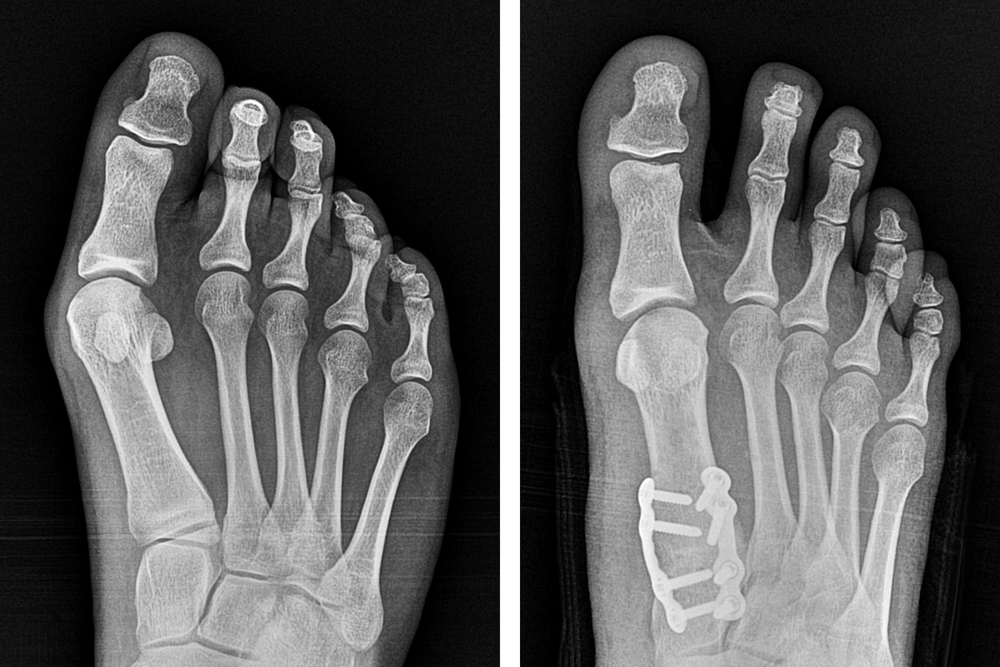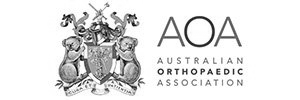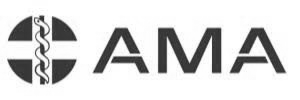Bunion
Surgery
What is Bunion Surgery
Bunion Surgery also referred to as Lapiplasty or Bunionectomy is the only means of correcting a bunion.
Surgery is also recommended when conservative measures fail to treat the symptoms of bunion.
There are many surgical options to treat a bunion. The common goal is to realign the bones in the foot, correct the deformity, and relieve pain and discomfort.
The surgery is performed as a day procedure, under the effect of a light general anaesthetic and a regional nerve block. When you wake up, you will not be in pain and will be able to walk on your foot straight away.
Types of Bunion Osteotomy Surgery
Osteotomy is a common type of bunion surgery that involves the surgical cutting and realignment of the bones around your big toe. Your surgeon selects the appropriate surgical procedure based on the type of bunion and its severity. There are 3 main types of osteotomies used by foot and ankle surgeons
Akin Osteotomy
Akin osteotomy corrects the sideways deviation of the big toe. In this procedure, your surgeon makes a small cut in the proximal phalanx (base of the big toe) and removes a wedge of bone to straighten the big toe. The bony fragments are then stabilized using a screw or staples. This procedure is often used in conjunction with the other procedures below.
Chevron Osteotomy
A chevron osteotomy is usually recommended for mild to moderate bunion deformities. During this procedure, your surgeon will make an incision over your big toe. The joint capsule is opened and the bunion is removed using a surgical saw.
A V-shaped cut is made on your big toe and the metatarsal bones are shifted to bring your toe into its normal anatomical position. The bunion is then shaved and the soft tissues are realigned to correct the position. Akin osteotomy may be performed if necessary. The mobility of your big toe is examined, and the capsule and wound are re-approximated with sutures. Screws or pins are used to hold the bones in their new position until healing.
This procedure can also be performed minimally invasively with keyhole style incisions.
Arthrodesis: Involves fusing the two bones that form the big toe joint. This procedure is used for severe bunions and when arthritis has set in. The movement of your big toe is reduced following this procedure but pain and deformity are very well controlled.
Scarf Osteotomy
Scarf osteotomy is usually recommended for moderate to severe bunion deformities. Your surgeon will make an incision along your big toe and open the joint capsule to expose the bump. The bump on your big toe is then removed using a bone saw.
Your first metatarsal bone is then cut in a Z shape and realigned to correct the deformity. Your surgeon will fix the cut bone with pins or screws. The joint capsule and surgical wounds are then reapproximated using dissolvable sutures keeping your toe in a straight position. This is a very powerful corrective procedure with excellent long term results.
Cheilectomy for Bunion (Hallux-Rigidus)
Cheilectomy is a surgical procedure, performed to remove a bony lump from the big toe of the foot in a medical condition known as Hallux-Rigidus. This bony lump develops on the first metatarsophalangeal joint, which is the main joint of the big toe.
This bony lump develops on the first metatarsophalangeal joint, which is the main joint of the big toe, and the surgery removes this bony lump caused by arthritis.
Minimally Invasive Cheilectomy of the 1st MTPJ
Cheilectomy is a procedure to remove excessive bone from the first metatarsophalangeal joint (MTPJ).
The MPT joints are the junctions between the metatarsal bones (long bones in the foot) and the proximal bones (bone in toes). The first MTPJ refers to the joint in the big toe of the foot. This surgery is intended to treat pain and stiffness and to increase the motion in the joint of the big toe. It may be performed in a minimally invasive manner through a very small incision.
Indications for Minimally Invasive Cheilectomy
Cheilectomy is designed to treat early arthritis and hallux rigidus. The surgery is performed to treat pain, stiffness and limited range of motion in the joint of the big toe which is caused due to arthritis.
Preparation for Bunion Surgery
Once you and the doctor have decided that surgery is required, preparation is necessary to achieve the best results and a quick and problem free recovery.
- Certain medications must be avoided. Your doctor may advise you to refrain from taking medications or dietary supplements that may increase your risk of bleeding.
- Fast beforehand. Depending on the type of anaesthesia you'll be receiving, your doctor may advise you to refrain from eating and drinking six to twelve hours before the procedure.
- Arrange for a ride. You will not be allowed to drive yourself home after the procedure, so make arrangements for someone to pick you up. If you live alone, arrange for someone to check on you that evening or, ideally, to stay with you for the rest of the day.
- Wear loose clothing. If you're having knee surgery, wear loose, comfortable clothing, such as baggy gym shorts and slip-on shoes, so you can easily dress after the procedure.
-
Things to Avoid
- Stop or cut down on smoking to reduce your surgery risks and improve your recovery
- Avoid chemical peels and needling
-
Pre Surgery Tests
- Pain medications are prescribed to help with pain during the recovery phase.
- After your operation, you will have a drip in your arm for pain medication and antibiotics.
- You may need between 1 - 3 nights in hospital.
- Crutches are required for 1 – 2 weeks following the replacement. Once you are off crutches, you can begin driving.
- If any postoperative problems arise with your knee, such as redness, increasing pain or fevers, do not hesitate to contact Dr Edward Graham. If unavailable, seek advice from the hospital or your doctor.
- Going home remember to arrange for someone to take you home, no driving is recommended.
-
Medication Information
- Regardless of whether you are expecting to have treatment or just a consultation please advise the doctor of any medications you are taking, including:
- Aspirin, Anti-inflammatory or Blood-thinning medications,
- discuss which ones should be stopped before surgery like aspirin, warfarin, anti-inflammatory medications or drugs that increase the risk of bleeding 7 days before surgery to minimise bleeding
- review blood replacement options (including banking blood) with your doctor
-
Physical & Mental Preparation
Physical Preparation
- Eat a well-balanced diet, supplemented by a daily multivitamin with iron.
- consider losing weight (if overweight) before surgery to help decrease the stress on the new joint.
- Treat any tooth, gum, bladder or bowel problems before surgery to reduce the risk of infection
Mental Preparation
Preparing mentally and physically for surgery is an important step toward a successful result.
Your doctor will create a treatment plan and patients will also need to understand the process and their role in it
Returning Home After Bunion Surgery
When you go home you need to take special precautions around the house to make sure it is safe. These may include:
- rails in your bathroom,
- modify your sleeping arrangements (especially if you are sleeping upstairs).
- You will be able to have a shower once the wound is healed, you may shower.
Assess your home situation to ensure you have adequate home support in the first few weeks following surgery. If you live alone it may be necessary to arrange a package of community care to help during the first few weeks at home.
Bunion Surgery Process
-
Day of Surgery
This procedure can be carried out under local anesthesia as well as general anesthesia, and the selection is made by the surgeon on a case by case basis.
The surgical procedure includes the administration of anesthesia, followed by an incision on the side of the big toe.
The surgeon proceeds to:
- remove the bony lump and any associated bone spurs,
- flush the joint, and
- stitching up the incision.
The toe is dressed and a cast is placed on the foot. The patient is brought out of anesthesia (in case of general anesthesia) and placed in the post-operative care unit.
The entire procedure is completed in under an hour.
-
Surgery Recovery
The patient is kept in the recovery room for observation and their vitals are monitored.
NSAIDs and paracetamol are given for pain management.
If the pain requires monitoring or in case of complications or use of general anesthesia, the patient is kept overnight.
At the end of the operation, local anaesthesia is injected into the ankle to provide post-operative pain relief for almost 10 hours.
Otherwise, the patient is given crutches to help with movement and discharged.
-
During Surgery
- The surgery is carried out as a day-case procedure (no overnight stay in the hospital) and under general anaesthesia.
- A single 2 cm incision or small keyhole incision is made on the top of the big toe.
- The excessive bone or build-up of bone at the joint, which blocks the normal movement of the toe, is excised and the skin is sutured with dissolvable stitches.
- In rare cases, the surgeon might recommend an additional surgery where 2 keyholes are made at the base of the big toe in order to align the joint.
- The procedure will be carried out under live X-ray guidance (fluoroscopy) and the surgeon may insert screws for stabilization of the alignment.
-
Post Surgery Care
- Crutches for the first 6 weeks
- Wearing a brace is not required while sleeping
The doctor will devise a care plan for the patient and request follows up, several weeks apart.
It is recommended to keep the foot elevated to help reduce swelling.
The sutures will be removed within two weeks.
The patient is also given a leaflet with information regarding post-operative care and he can his doctor any questions that he may have.
Bunion Surgery Rehabilitation Program
-
1 Week - Post Op Rehabilitation
Recovery after surgery requires:
- Keeping the sutures clean and changing bandages as needed.
- Pain relief using Paracetamol can also be taken on an as per need basis.
- Patients can return to work as early as three weeks if they have a desk job and can take up to three months for recovery if their job requires heavy labour.
- Driving can also be resumed within 2-3 weeks after surgery.
-
6 Weeks - Post Op Rehabilitation
- Your weight-bearing is advanced to full weight
- At 6 weeks, your brace is replaced with a lateral stabilizer brace.
- At 8 weeks postoperatively, all brace use can be discontinued.
-
32 Weeks - Post Op Rehabilitation
-
4 Weeks - Post Op Rehabilitation
- You will be added with progressive quadriceps strengthening and straight-leg raises can be trained with an unlocked brace if there is no patellar lag.
- Weight-bearing is restricted to toe touch with crutches for the first four weeks.
- You will be asked to keep your foot in an elevated position and take anti-inflammatory medications to minimize swelling. A surgical shoe is worn for 1 week initially after surgery to avoid infection.
- The physiotherapists will guide you with mobilisation exercises to reduce muscle tightness after which you will be able to walk gradually and resume daily activities.
- You will be advised not to drive a vehicle for 3 weeks and not to wear high heels for 6-8 weeks.
-
10 Weeks - Post Op Rehabilitation
-
52 Weeks - Post Op Rehabilitation
Risks & Complications Associated with Bunion Surgery
-
General Risks with Surgery
General Complications With Surgery
All operations have risks. Apart from pain, most patients don’t have any of these problems. The general risk of a surgical complication is about 5%, the Risk of serious complications is less than 1%. General complications from surgery can include:
- Anesthetics - Allergic reactions to medications
- Bleeding & Blood Loss -Blood loss requiring transfusion with its low risk of disease transmission
- Blood Clotting - Blood clots can form in the leg’s calf muscles causing Deep Venous Thrombosis (DVT) and can travel to the lung (Pulmonary Embolism). These can occasionally be serious and even life-threatening (Heart Attack, Stroke). If you get calf pain or shortness of breath at any stage, you should notify your surgeon.
- Infection - During or Postoperative Infection can occur with any operation. Infection rates are approximately 1%, if an infection occurs it can be treated with antibiotics but may require further surgery. Very rarely your hip may need to be removed to eradicate infection.
- Death Due to Surgery - Serious medical problems can lead to ongoing health concerns (kidney failure, pneumonia, bladder infections, causing prolonged hospitalization and in rare cases death.
- Delayed Healing - Some patients take longer to heal than others, particularly people with more than one illness
- Difficulty Breathing - Most patients can be removed from the breathing machine after their surgery. Some patients can require the ventilator longer or lung function rehab
- Surgical Injury - When having surgery there is the risk that parts of the body will be damaged in the process
- Other Complications - Tingling, Numbness or Discomfort Around the Operative Region, Swelling & Bruising, Muscle Stiffness, Reflex Sympathetic Dystrophy, Scarring
-
Specific Risks with Your Surgery
As with any surgery, bunion surgery involves certain risks and complications. They include:
- Recurrence of the bunion
- Nerve damage
- Unresolved pain and swelling
- Joint stiffness or restricted movement
- Delayed healing or healing in the wrong position
In rare cases, a second surgery may be necessary to correct the problems.
In addition to the normal risks associated with surgery, the incision site can become infected.
There can also be a loss of sensation or tingling on the big toe for up to six weeks after surgery.
Risks associated with cheilectomy are:
- Deep vein thrombosis
Around 80% of the people who have undergone cheilectomy have found it to be effective and safe.
Surgical Follow Ups
-
2 Weeks After Surgery
- Check Up with Surgeon
- X Rays
-
12 Weeks After Surgery
- Check-Up with Surgeon
- X Rays
- After 3 months, more physical activities, such as sports will be possible
-
1 Year After Surgery
- Check Up with Surgeon
- X Rays
-
6 Weeks After Surgery
Your foot will be dressed with a bandage that will be removed after 7 days. You will be asked to keep your foot in an elevated position and take anti-inflammatory medications to minimize swelling. A surgical shoe is worn for 1 week initially after surgery to avoid infection. The physiotherapists will guide you with mobilisation exercises to reduce muscle tightness after which you will be able to walk gradually and resume daily activities. You will be advised not to drive a vehicle for 3 weeks and not to wear high heels for 6-8 weeks.
-
32 Weeks After Surgery
- Check Up with Surgeon
- X Rays
-
Ongoing Care
You should continue to see your surgeon for the rest of your life to check your knee and take X-rays.
This is important as sometimes your knee can feel excellent, but there can be a problem only recognised on X-ray
How Risks Are Minimised
Get Moving Quickly
Early mobilisation is a major preventive measure. We strongly encourage you to get moving and out of bed as soon as possible after the operation to restore normal blood flow in the legs.
You should aim to do at least ten short walks (of between 2 and 5 minutes) each day in the first two weeks after surgery.
How Can I Minimise Post Operative Complications
Blood clots (DVT or PE)
All patients receive a number of treatment measures to reduce the risk of blood clots. These include
- Injections of heparin during and after surgery, and
- Sequential calf compression device
As a result of these measures, we have never had a patient develop a deep venous thrombosis. Any patient who is at high risk of a blood clot (such as a history of blood clots or clotting disorders) may be asked to continue heparin (Clexane) injections for 10 days after the surgery in addition to the other measures.
This can be done at home, and we will show you how.
What Are the Consequences of Surgery?
Sometimes the potential risks and consequences of your surgical procedure need to be weighed against the benefits of a successful surgical outcome.
Like most surgery these benefits can include:
- Freedom from pain
- Increase movement
- Greater Flexibility,
- Maintained Independence
- Improved outlook, and
- Longer more enjoyable life
Although the recurrence of the presenting problem is not very common, after surgery, you would need to follow preventive measures.
It is important to avoid high impact activities during the early phase of recovery to minimise the risk of further injury. If there are any postoperative concerns or pain, please do not hesitate in contacting [doctor] or the rooms.






